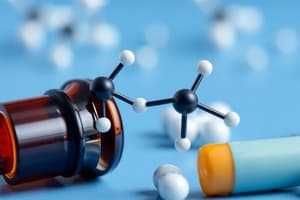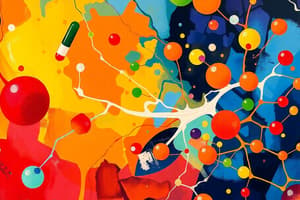Podcast
Questions and Answers
Which of the following characteristics distinguishes true cholinesterase (ChE) from pseudo ChE?
Which of the following characteristics distinguishes true cholinesterase (ChE) from pseudo ChE?
- Both are synthesized in the liver.
- True ChE is found primarily in plasma.
- True ChE's deficiency is not fatal.
- True ChE specifically metabolizes acetylcholine. (correct)
How do indirect-acting parasympathomimetic drugs affect acetylcholine levels in the synapse?
How do indirect-acting parasympathomimetic drugs affect acetylcholine levels in the synapse?
- By directly binding to and activating acetylcholine receptors
- By inhibiting the breakdown of acetylcholine in the synaptic cleft (correct)
- By inhibiting the reuptake of acetylcholine into presynaptic neurons
- By directly stimulating the release of acetylcholine from presynaptic neurons
Which of the following correctly describes the mechanism of action of reversible cholinesterase inhibitors?
Which of the following correctly describes the mechanism of action of reversible cholinesterase inhibitors?
- They form a permanent covalent bond with cholinesterase, leading to irreversible inactivation of the enzyme.
- They competitively bind to the active site of cholinesterase, preventing the breakdown of acetylcholine. (correct)
- They accelerate the degradation of cholinesterase, reducing its concentration in the synaptic cleft.
- They stimulate the production of cholinesterase, leading to increased acetylcholine hydrolysis.
Why is physostigmine able to be used in both the treatment of glaucoma and as an antidote for atropine poisoning?
Why is physostigmine able to be used in both the treatment of glaucoma and as an antidote for atropine poisoning?
A patient presents with symptoms of myasthenia gravis. Edrophonium is administered, and the patient's muscle strength temporarily improves. What is the significance of this?
A patient presents with symptoms of myasthenia gravis. Edrophonium is administered, and the patient's muscle strength temporarily improves. What is the significance of this?
What is the primary difference between pyridostigmine and neostigmine in treating myasthenia gravis?
What is the primary difference between pyridostigmine and neostigmine in treating myasthenia gravis?
How do the central mechanisms of action of donepezil and rivastigmine contribute to their therapeutic effect in Alzheimer's disease?
How do the central mechanisms of action of donepezil and rivastigmine contribute to their therapeutic effect in Alzheimer's disease?
A farmer is accidentally exposed to a high concentration of organophosphate insecticide. What is the immediate and most critical physiological effect of this exposure?
A farmer is accidentally exposed to a high concentration of organophosphate insecticide. What is the immediate and most critical physiological effect of this exposure?
What is the underlying mechanism of 'aging' in the context of organophosphate poisoning, and why is it clinically significant?
What is the underlying mechanism of 'aging' in the context of organophosphate poisoning, and why is it clinically significant?
Which of the following is the underlying cause of death in organophosphate poisoning?
Which of the following is the underlying cause of death in organophosphate poisoning?
Which intervention has the highest priority in the initial management of a patient presenting with acute organophosphate poisoning?
Which intervention has the highest priority in the initial management of a patient presenting with acute organophosphate poisoning?
Atropine is a critical antidote in organophosphate poisoning. What is the primary mechanism by which atropine counteracts the effects of organophosphates?
Atropine is a critical antidote in organophosphate poisoning. What is the primary mechanism by which atropine counteracts the effects of organophosphates?
How does pralidoxime interact with the acetylcholinesterase enzyme-organophosphate complex, and under what circumstances is it most effective?
How does pralidoxime interact with the acetylcholinesterase enzyme-organophosphate complex, and under what circumstances is it most effective?
Which medication would be administered to manage seizures in a patient with organophosphate poisoning?
Which medication would be administered to manage seizures in a patient with organophosphate poisoning?
Which of the following is known to have the longest duration of action?
Which of the following is known to have the longest duration of action?
Edrophonium is a short acting AChE inhibitor used primarily for:
Edrophonium is a short acting AChE inhibitor used primarily for:
How does physostigmine manage glaucoma?
How does physostigmine manage glaucoma?
What explains why neostigmine is unable to treat glaucoma?
What explains why neostigmine is unable to treat glaucoma?
Which of the following best describes the mechanism by which donepezil improves cognitive function in patients with Alzheimer's disease?
Which of the following best describes the mechanism by which donepezil improves cognitive function in patients with Alzheimer's disease?
Which diagnostic agent is used to diagnose Myasthenia Gravis?
Which diagnostic agent is used to diagnose Myasthenia Gravis?
Flashcards
Cholinesterase Types
Cholinesterase Types
Cholinesterase enzymes are of two types: True ChE and Pseudo ChE, each with different locations and substrate specificity.
Cholinesterase Inhibitors
Cholinesterase Inhibitors
Indirect-acting parasympathomimetic drugs inhibit cholinesterase, increasing acetylcholine levels.
Reversible Inhibitors
Reversible Inhibitors
Reversible cholinesterase inhibitors include Physostigmine, Neostigmine, Pyridostigmine and Donepezil.
Irreversible Inhibitors
Irreversible Inhibitors
Signup and view all the flashcards
Physostigmine
Physostigmine
Signup and view all the flashcards
Neostigmine
Neostigmine
Signup and view all the flashcards
Pyridostigmine
Pyridostigmine
Signup and view all the flashcards
Edrophonium
Edrophonium
Signup and view all the flashcards
Central Cholinesterase Inhibitors
Central Cholinesterase Inhibitors
Signup and view all the flashcards
Organophosphates
Organophosphates
Signup and view all the flashcards
Organophosphate Treatment
Organophosphate Treatment
Signup and view all the flashcards
Study Notes
Indirect Cholinergic Agonists
- Indirect cholinergic agonists are covered, including their classification, mechanism of action, and uses.
- Organophosphorus poisoning is also addressed.
Cholinesterase Types
- True Cholinesterase (ChE):
- Found in ganglia, neuromuscular junctions (NMJ), and the central nervous system (CNS).
- Specifically metabolizes acetylcholine (Ach).
- Deficiency is fatal, regenerates in 2-3 months.
- Pseudo Cholinesterase (ChE):
- Located in plasma and the liver.
- Metabolizes Ach and other drugs like succinylcholine.
- Deficiency is not fatal, regenerates in 2-3 weeks.
Indirect-Acting Parasympathomimetic Drugs
- These drugs are cholinesterase inhibitors.
- Reversible Inhibitors:
- Physostigmine
- Neostigmine
- Pyridostigmine
- Donepezil
- Irreversible Inhibitors:
- Organophosphate compounds
Physostigmine
- Derived from a natural plant alkaloid and is a tertiary amine.
- Well-absorbed from the gastrointestinal tract (GIT).
- Capable of crossing into the CNS.
- It is a reversible cholinesterase inhibitor, increasing endogenous Ach, which affects muscarinic (M) and nicotinic (N) receptors.
- It is used to treat glaucoma (as eye drops) and as an antidote for atropine poisoning.
Neostigmine
- Synthetic and a quaternary ammonium compound.
- Poorly absorbed from the GIT.
- Cannot pass into the CNS.
- It is a reversible cholinesterase inhibitor, increasing endogenous Ach, which affects M and N receptors.
-Directly stimulates Nm receptors at the NMJ.
- It is used to treat myasthenia gravis, post-operative retention of urine, post-operative paralytic ileus, and as an antidote to D-tubocurarine.
Neostigmine Substitutes
- Pyridostigmine:
- Has a longer duration of action than neostigmine.
- More selective on the NMJ than neostigmine.
- Used to treat myasthenia gravis.
- Edrophonium:
- Very short-acting (5 minutes).
- More selective on the NMJ than neostigmine.
- Used for the diagnosis of myasthenia gravis.
Central Cholinesterase Inhibitors
- Donepezil and Rivastigmine:
- Can cross the blood-brain barrier.
- Increases acetylcholine levels at central cholinergic synapses.
- Used to treat Alzheimer's disease and improve cognitive functions.
Organophosphorus Compounds
- Examples:
- Echothiophate (eye drops for glaucoma)
- Insecticides like parathion and malathion
- Nerve gases like sarin and soman
- Highly lipid-soluble and rapidly absorbed through all routes, including the skin.
- Exhibits rapid CNS penetration.
- Irreversibly inhibits cholinesterase, leading to increased endogenous Ach at synapses and severe muscarinic and nicotinic symptoms.
- Aging of the ChE enzyme results in complete enzyme inhibition, with the bond strengthening within 12 hours.
Manifestations of Organophosphate Poisoning (Toxicity)
- Diarrhea
- Urination
- Miosis
- Bradycardia
- Bronchospasm
- Lacrimation, salivation, and sweating
- Emesis, excitation of the CNS (hallucinations, convulsions, and coma)
- Skeletal muscle twitches and paralysis
- Respiratory failure is the main cause of death, due to blocked airway, paralyzed respiratory muscles, and inhibited respiratory center (RC).
Treatment of Organophosphate Toxicity
- Ensure a patent airway and provide artificial respiration.
- Perform a stomach wash and skin wash.
- Administer intravenous normal saline to raise blood pressure (BP).
- Administer the following drugs:
- Atropine: Antagonizes peripheral and central muscarinic manifestations, and should be given in high doses.
- Pralidoxime: A cholinesterase re-activator that dephosphorylates the ChE, effective only before enzyme aging (within 12 hours).
- Diazepam: Used to control convulsions.
Studying That Suits You
Use AI to generate personalized quizzes and flashcards to suit your learning preferences.




